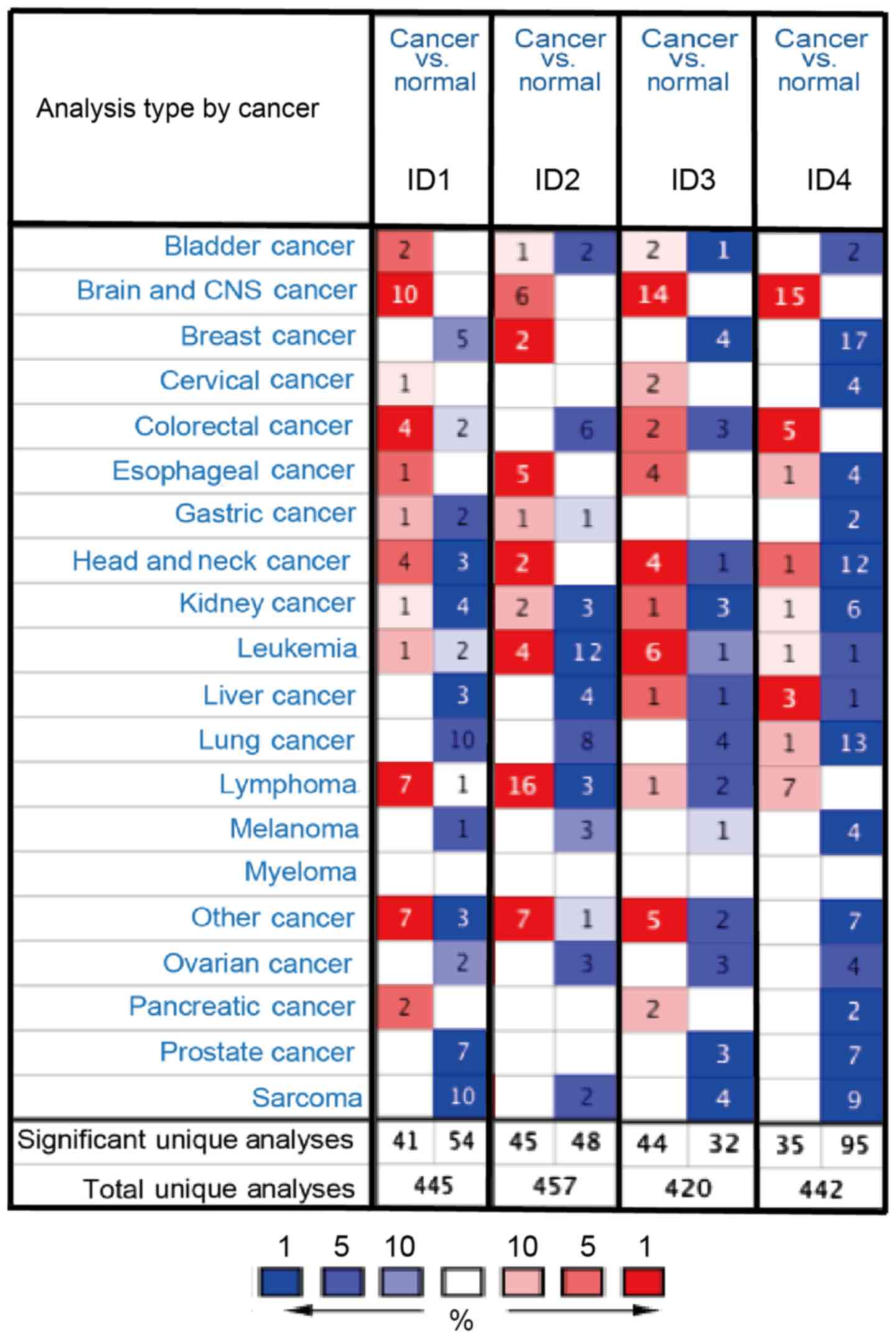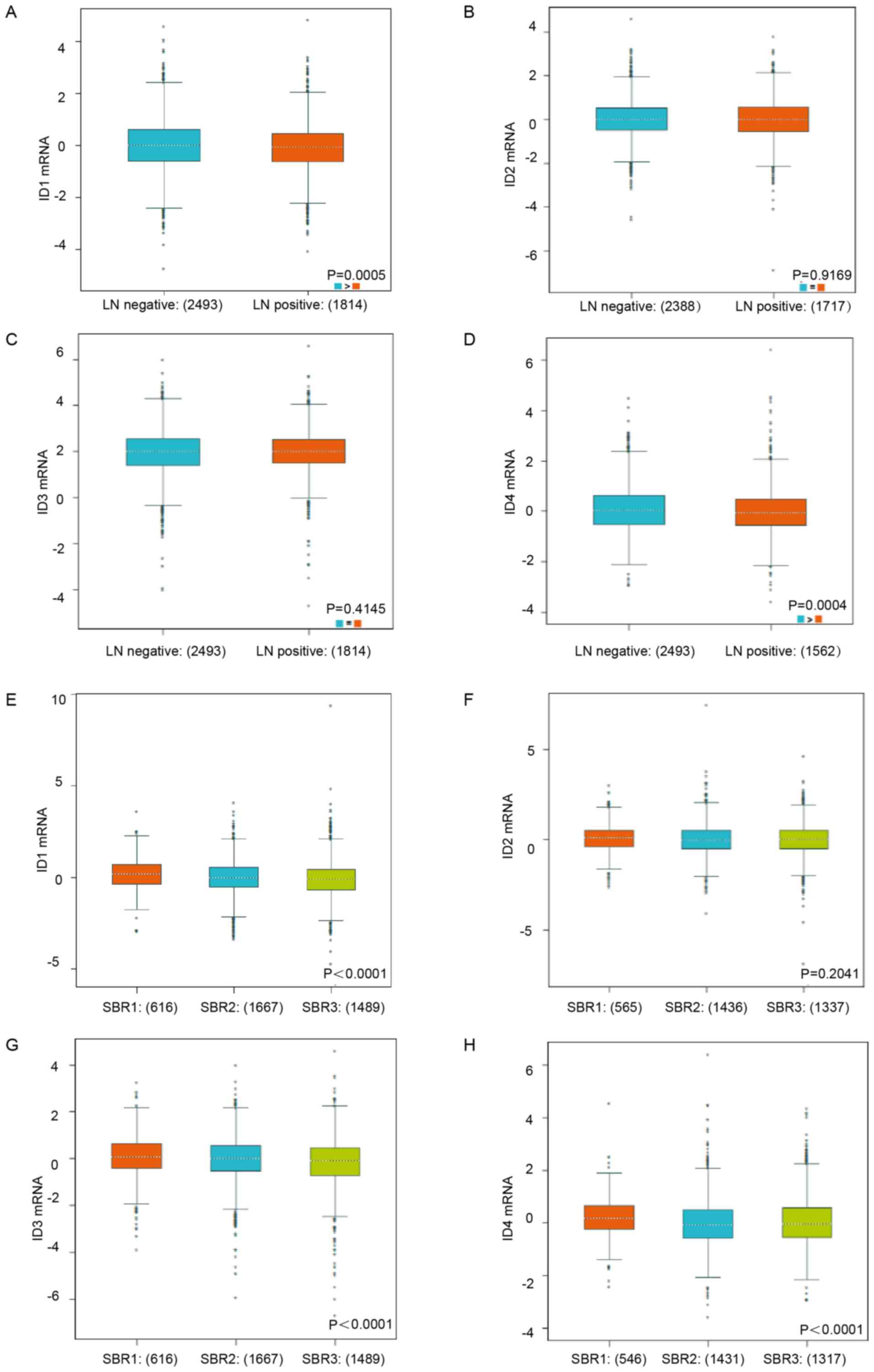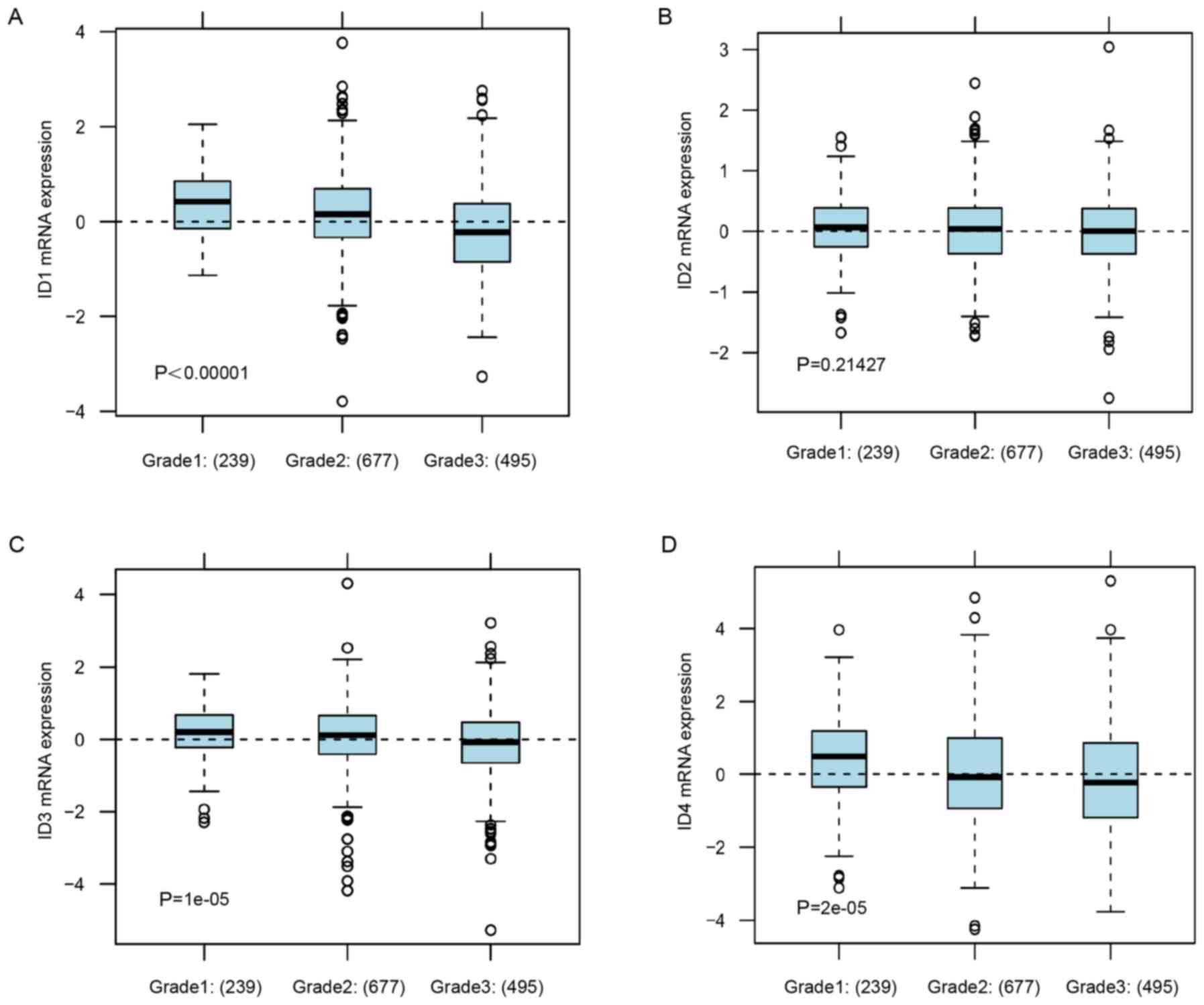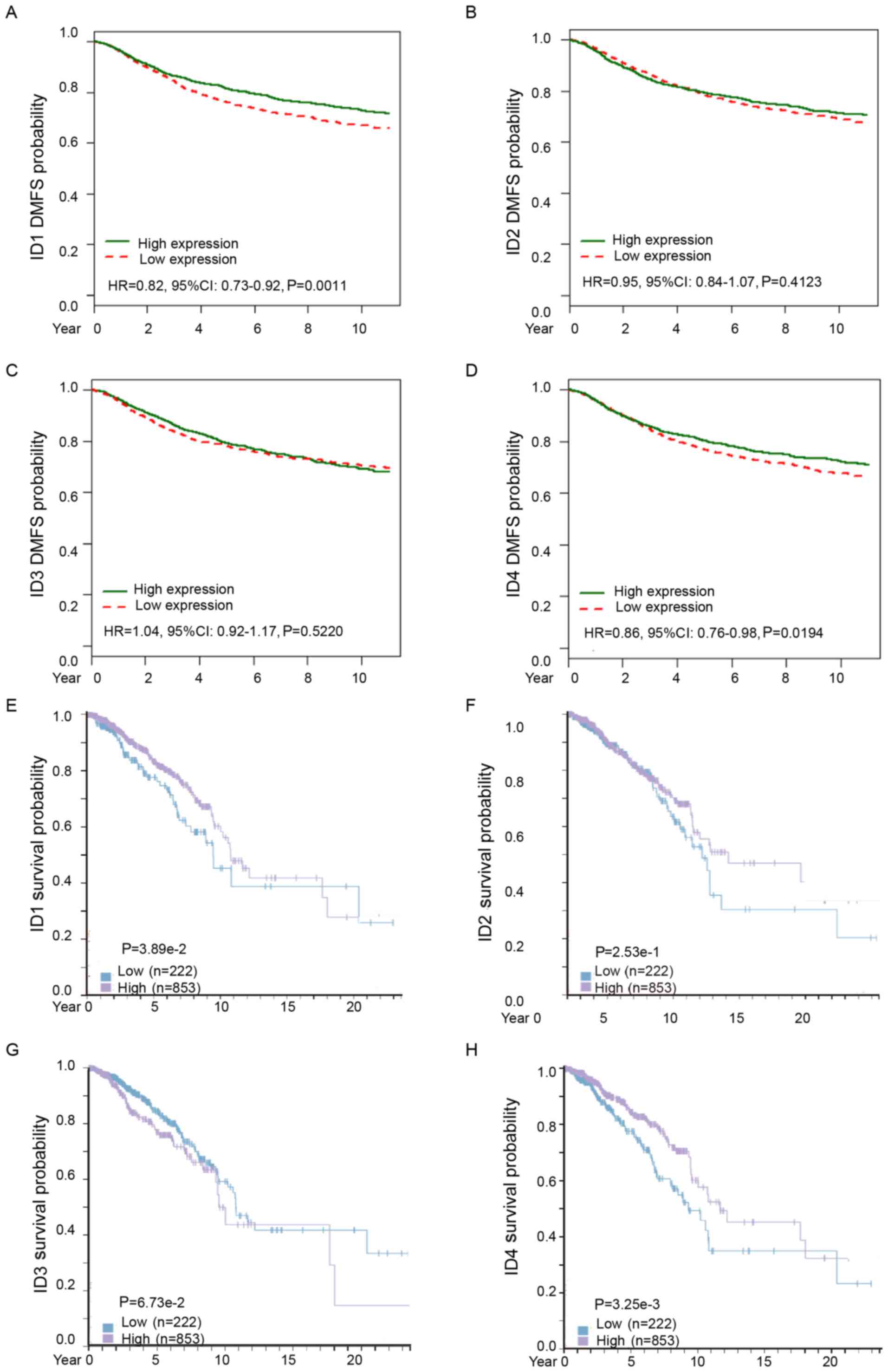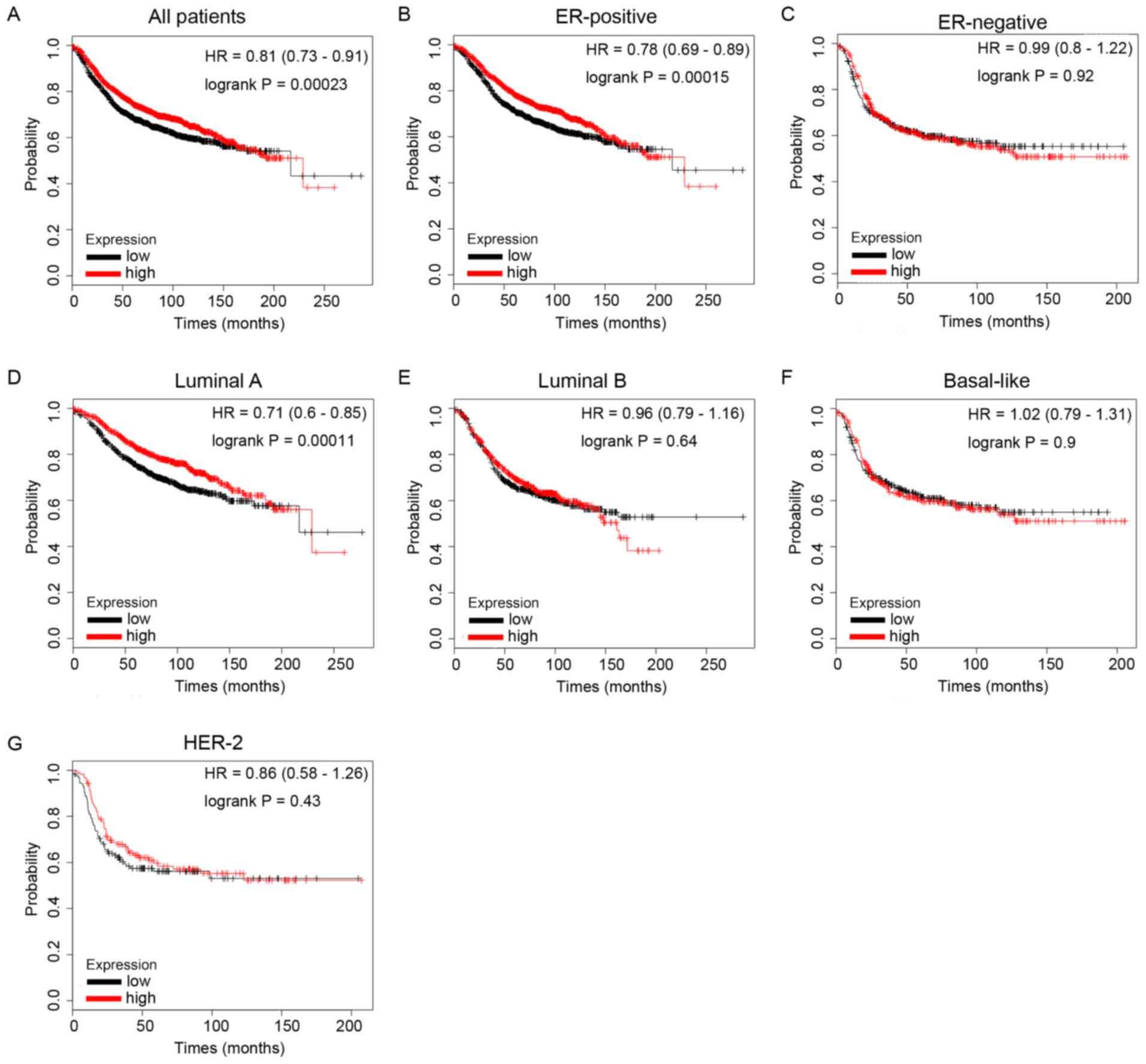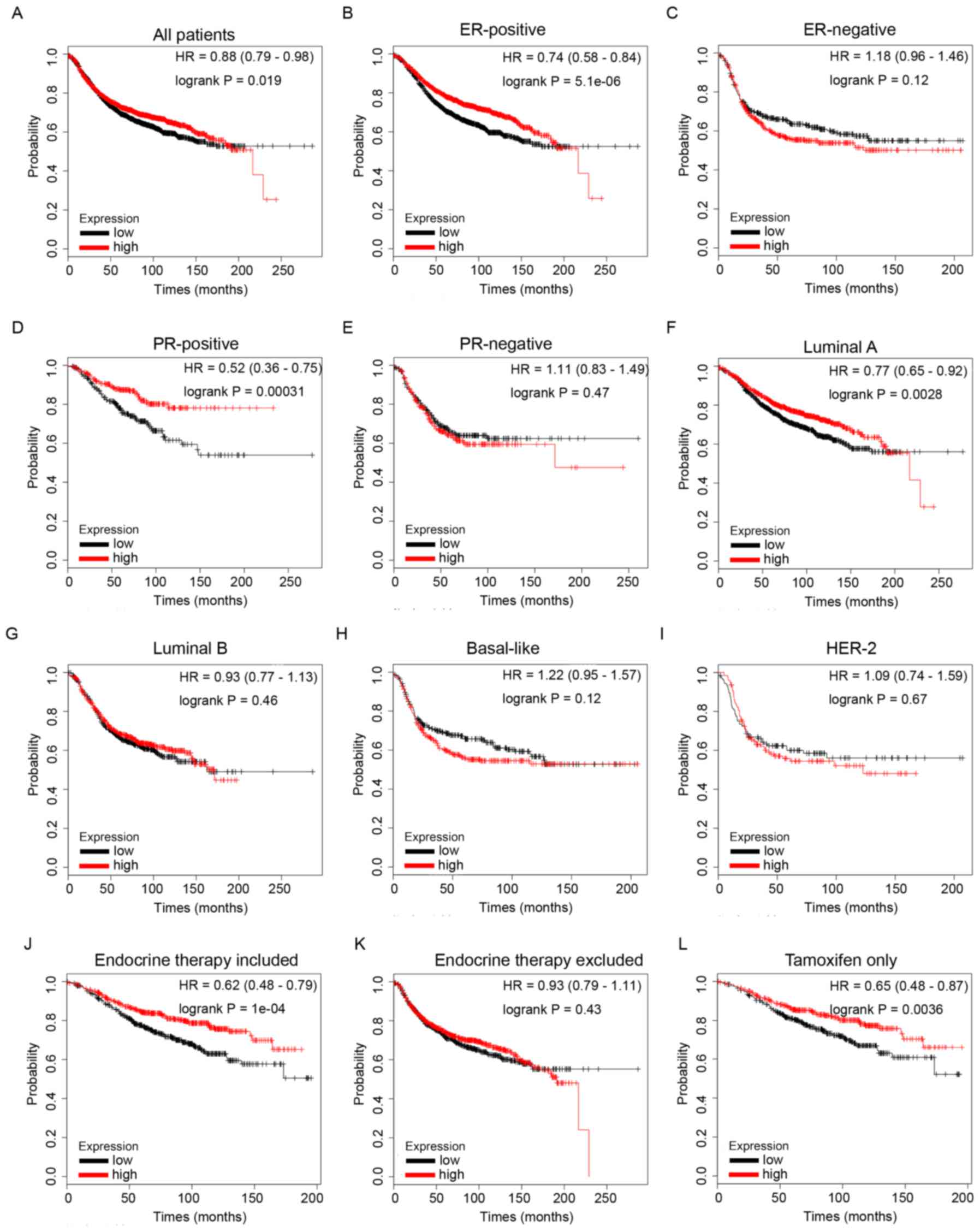|
1
|
Yokota Y and Mori S: Role of Id family
proteins in growth control. J Cell Physiol. 190:21–28. 2002.
View Article : Google Scholar : PubMed/NCBI
|
|
2
|
Patel D, Morton DJ, Carey J, Havrda MC and
Chaudhary J: Inhibitor of differentiation 4 (ID4): From development
to cancer. Biochim Biophys Acta. 1855:92–103. 2015.PubMed/NCBI
|
|
3
|
Kamalian L, Gosney JR, Forootan SS, Foster
CS, Bao ZZ, Beesley C and Ke Y: Increased expression of Id family
proteins in small cell lung cancer and its prognostic significance.
Clin Cancer Res. 14:2318–2325. 2008. View Article : Google Scholar : PubMed/NCBI
|
|
4
|
Cruz-Rodriguez N, Combita AL, Enciso LJ,
Quijano SM, Pinzon PL, Lozano OC, Castillo JS, Li L, Bareño J,
Cardozo C, et al: High expression of ID family and IGJ genes
signature as predictor of low induction treatment response and
worst survival in adult Hispanic patients with B-acute
lymphoblastic leukemia. J Exp Clin Cancer Res. 35:642016.
View Article : Google Scholar : PubMed/NCBI
|
|
5
|
Perk J, Iavarone A and Benezra R: Id
family of helix-loop-helix proteins in cancer. Nat Rev Cancer.
5:603–614. 2005. View
Article : Google Scholar : PubMed/NCBI
|
|
6
|
O'Brien CA, Kreso A, Ryan P, Hermans KG,
Gibson L, Wang Y, Tsatsanis A, Gallinger S and Dick JE: ID1 and ID3
regulate the self-renewal capacity of human colon cancer-initiating
cells through p21. Cancer Cell. 21:777–792. 2012. View Article : Google Scholar : PubMed/NCBI
|
|
7
|
Ren Y, Cheung HW, von Maltzhan G, Agrawal
A, Cowley GS, Weir BA, Boehm JS, Tamayo P, Karst AM, Liu JF, et al:
Targeted tumor-penetrating siRNA nanocomplexes for credentialing
the ovarian cancer oncogene ID4. Sci Transl Med. 4:147ra1122012.
View Article : Google Scholar : PubMed/NCBI
|
|
8
|
Zhao TF, Jia HZ, Zhang ZZ, Zhao XS, Zou
YF, Zhang W, Wan J and Chen XF: LncRNA H19 regulates ID2 expression
through competitive binding to hsa-miR-19a/b in acute myelocytic
leukemia. Mol Med Rep. 16:3687–3693. 2017. View Article : Google Scholar : PubMed/NCBI
|
|
9
|
Korang-Yeboah M, Patel D, Morton D, Sharma
P, Gorantla Y, Joshi J, Nagappan P, Pallaniappan R and Chaudhary J:
Intra-tumoral delivery of functional ID4 protein via
PCL/maltodextrin nano-particle inhibits prostate cancer growth.
Oncotarget. 7:68072–68085. 2016. View Article : Google Scholar : PubMed/NCBI
|
|
10
|
Minn AJ, Gupta GP, Siegel PM, Bos PD, Shu
W, Giri DD, Viale A, Olshen AB, Gerald WL and Massagué J: Genes
that mediate breast cancer metastasis to lung. Nature. 436:518–524.
2005. View Article : Google Scholar : PubMed/NCBI
|
|
11
|
Gupta GP, Perk J, Acharyya S, de Candia P,
Mittal V, Todorova-Manova K, Gerald WL, Brogi E, Benezra R and
Massagué J: ID genes mediate tumor reinitiation during breast
cancer lung metastasis. Proc Natl Acad Sci USA. 104:19506–19511.
2007. View Article : Google Scholar : PubMed/NCBI
|
|
12
|
Lasorella A, Benezra R and Iavarone A: The
ID proteins: Master regulators of cancer stem cells and tumour
aggressiveness. Nat Rev Cancer. 14:77–91. 2014. View Article : Google Scholar : PubMed/NCBI
|
|
13
|
Sikder HA, Devlin MK, Dunlap S, Ryu B and
Alani RM: Id proteins in cell growth and tumorigenesis. Cancer
Cell. 3:525–530. 2003. View Article : Google Scholar : PubMed/NCBI
|
|
14
|
Sun XH, Copeland NG, Jenkins NA and
Baltimore D: Id proteins Id1 and Id2 selectively inhibit DNA
binding by one class of helix-loop-helix proteins. Mol Cell Biol.
11:5603–5611. 1991. View Article : Google Scholar : PubMed/NCBI
|
|
15
|
Rollin J, Bléchet C, Régina S, Tenenhaus
A, Guyétant S and Gidrol X: The intracellular localization of ID2
expression has a predictive value in non small cell lung cancer.
PLoS One. 4:e41582009. View Article : Google Scholar : PubMed/NCBI
|
|
16
|
Chen XS, Zhang YH, Cai QY and Yao ZX: ID2:
A negative transcription factor regulating oligodendroglia
differentiation. J Neurosci Res. 90:925–932. 2012. View Article : Google Scholar : PubMed/NCBI
|
|
17
|
Kleeff J, Ishiwata T, Friess H, Buchler
MW, Israel MA and Korc M: The helix-loop-helix protein Id2 is
overexpressed in human pancreatic cancer. Cancer Res. 58:3769–3772.
1998.PubMed/NCBI
|
|
18
|
Li K, Yao L, Chen L, Cao ZG, Yu SJ, Kuang
XY, Hu X and Shao ZM: ID2 predicts poor prognosis in breast cancer,
especially in triple-negative breast cancer, and inhibits
E-cadherin expression. Onco Targets Ther. 7:1083–1094.
2014.PubMed/NCBI
|
|
19
|
Itahana Y, Singh J, Sumida T, Coppe JP,
Parrinello S, Bennington JL and Desprez PY: Role of Id-2 in the
maintenance of a differentiated and noninvasive phenotype in breast
cancer cells. Cancer Res. 63:7098–7105. 2003.PubMed/NCBI
|
|
20
|
Stighall M, Manetopoulos C, Axelson H and
Landberg G: High ID2 protein expression correlates with a
favourable prognosis in patients with primary breast cancer and
reduces cellular invasiveness of breast cancer cells. Int J Cancer.
115:403–411. 2005. View Article : Google Scholar : PubMed/NCBI
|
|
21
|
Kowanetz M, Valcourt U, Bergström R,
Heldin CH and Moustakas A: Id2 and Id3 define the potency of cell
proliferation and differentiation responses to transforming growth
factor beta and bone morphogenetic protein. Mol Cell Biol.
24:4241–4254. 2004. View Article : Google Scholar : PubMed/NCBI
|
|
22
|
Wen YH, Ho A, Patil S, Akram M, Catalano
J, Eaton A, Norton L, Benezra R and Brogi E: Id4 protein is highly
expressed in triple-negative breast carcinomas: Possible
implications for BRCA1 downregulation. Breast Cancer Res Treat.
135:93–102. 2012. View Article : Google Scholar : PubMed/NCBI
|
|
23
|
Thike AA, Tan PH, Ikeda M and Iqbal J:
Increased ID4 expression, accompanied by mutant p53 accumulation
and loss of BRCA1/2 proteins in triple-negative breast cancer,
adversely affects survival. Histopathology. 68:702–712. 2016.
View Article : Google Scholar : PubMed/NCBI
|
|
24
|
Lin HY, Zeng Liang YK, Wei XL and Chen CF:
GATA3 and TRPS1 are distinct biomarkers and prognostic factors in
breast cancer: Database mining for GATA family members in
malignancies. Oncotarget. 8:34750–34761. 2017.PubMed/NCBI
|
|
25
|
Jezequel P, Frenel JS, Campion L,
Guérin-Charbonnel C, Gouraud W, Ricolleau G and Campone M:
bc-GenExMiner 3.0: New mining module computes breast cancer gene
expression correlation analyses. Database. 2013:bas0602013.
View Article : Google Scholar : PubMed/NCBI
|
|
26
|
Jezequel P, Campone M, Gouraud W,
Guérin-Charbonnel C, Leux C, Ricolleau G and Campion L:
bc-GenExMiner: An easy-to-use online platform for gene prognostic
analyses in breast cancer. Breast Cancer Res Treat. 131:765–775.
2012. View Article : Google Scholar : PubMed/NCBI
|
|
27
|
Thul PJ, Akesson L, Wiking M, Mahdessian
D, Geladaki A, Blal Ait H, Alm T, Asplund A, Björk L, Breckels LM,
et al: A subcellular map of the human proteome. Science. 356:pii:
eaal3321. 2017. View Article : Google Scholar : PubMed/NCBI
|
|
28
|
Uhlen M, Fagerberg L, Hallstrom BM,
Lindskog C, Oksvold P, Mardinoglu A, Sivertsson Å, Kampf C,
Sjöstedt E, Asplund A, et al: Proteomics. Tissue-based map of the
human proteome. Science. 347:12604192015. View Article : Google Scholar : PubMed/NCBI
|
|
29
|
Gyorffy B, Lanczky A, Eklund AC, Denkert
C, Budczies J, Li Q and Szallasi Z: An online survival analysis
tool to rapidly assess the effect of 22,277 genes on breast cancer
prognosis using microarray data of 1,809 patients. Breast Cancer
Res Treat. 123:725–731. 2010. View Article : Google Scholar : PubMed/NCBI
|
|
30
|
Curtit E, Pivot X, Henriques J,
Paget-Bailly S, Fumoleau P, Rios M, Bonnefoi H, Bachelot T, Soulié
P, Jouannaud C, et al: Assessment of the prognostic role of a
94-single nucleotide polymorphisms risk score in early breast
cancer in the SIGNAL/PHARE prospective cohort: No correlation with
clinico-pathological characteristics and outcomes. Breast Cancer
Res. 19:982017. View Article : Google Scholar : PubMed/NCBI
|
|
31
|
Fragomeni SM, Sciallis A and Jeruss JS:
Molecular subtypes and local-regional control of breast cancer.
Surg Oncol Clin N Am. 27:95–120. 2018. View Article : Google Scholar : PubMed/NCBI
|
|
32
|
Pawlik TM: Innovation in the diagnosis and
management of breast cancer. Surg Oncol Clin N Am. 27:xiii–xiv.
2018. View Article : Google Scholar
|
|
33
|
Murad JM, Place CS, Ran C, Hekmatyar SK,
Watson NP, Kauppinen RA and Israel MA: Inhibitor of DNA binding 4
(ID4) regulation of adipocyte differentiation and adipose tissue
formation in mice. J Biol Chem. 285:24164–24173. 2010. View Article : Google Scholar : PubMed/NCBI
|
|
34
|
Yang HY, Liu HL, Ke J, Wu H, Zhu H, Liu
JR, Liu LX and Jiang HC: Expression and prognostic value of Id
protein family in human breast carcinoma. Oncol Rep. 23:321–328.
2010.PubMed/NCBI
|
|
35
|
Wazir U, Jiang WG, Sharma AK, Newbold RF
and Mokbel K: The mRNA expression of inhibitors of DNA binding-1
and −2 is associated with advanced tumour stage and adverse
clinical outcome in human breast cancer. Anticancer Res.
33:2179–2183. 2013.PubMed/NCBI
|
|
36
|
Umetani N, Mori T, Koyanagi K, Shinozaki
M, Kim J, Giuliano AE and Hoon DS: Aberrant hypermethylation of ID4
gene promoter region increases risk of lymph node metastasis in T1
breast cancer. Oncogene. 24:4721–4727. 2005. View Article : Google Scholar : PubMed/NCBI
|
|
37
|
Li B, Tsao SW, Li YY, Wang X, Ling MT,
Wong YC, He QY and Cheung AL: Id-1 promotes tumorigenicity and
metastasis of human esophageal cancer cells through activation of
PI3K/AKT signaling pathway. Int J Cancer. 125:2576–2585. 2009.
View Article : Google Scholar : PubMed/NCBI
|
|
38
|
Gumireddy K, Li A, Kossenkov AV, Cai KQ,
Liu Q, Yan J, Xu H, Showe L, Zhang L and Huang Q: ID1 promotes
breast cancer metastasis by S100A9 regulation. Mol Cancer Res.
12:1334–1343. 2014. View Article : Google Scholar : PubMed/NCBI
|
|
39
|
Cheng YJ, Lee YC, Chiu WC, Tsai JW, Su YH,
Hung AC, Chang PC, Huang CJ, Chai CY and Yuan SS: High Id1
expression, a generally negative prognostic factor, paradoxically
predicts a favorable prognosis for adjuvant paclitaxel plus
cisplatin therapy in surgically treated lung cancer patients.
Oncotarget. 5:11564–11575. 2014. View Article : Google Scholar : PubMed/NCBI
|
|
40
|
Zhang Y, Zhang B, Fang J and Cao X:
Hypomethylation of DNA-binding inhibitor 4 serves as a potential
biomarker in distinguishing acquired tamoxifen-refractory breast
cancer. Int J Clin Exp Pathol. 8:9500–9505. 2015.PubMed/NCBI
|
|
41
|
Patel D, Knowell AE, Korang-Yeboah M,
Sharma P, Joshi J, Glymph S, Chinaranagari S, Nagappan P,
Palaniappan R, Bowen NJ and Chaudhary J: Inhibitor of
differentiation 4 (ID4) inactivation promotes de novo
steroidogenesis and castration-resistant prostate cancer. Mol
Endocrinol. 28:1239–1253. 2014. View Article : Google Scholar : PubMed/NCBI
|
|
42
|
Sharma P, Chinaranagari S and Chaudhary J:
Inhibitor of differentiation 4 (ID4) acts as an inhibitor of ID-1,
−2 and −3 and promotes basic helix loop helix (bHLH) E47 DNA
binding and transcriptional activity. Biochimie. 112:139–150. 2015.
View Article : Google Scholar : PubMed/NCBI
|















